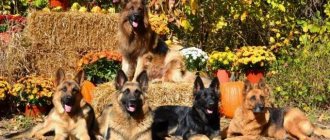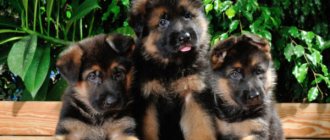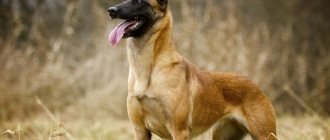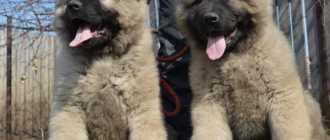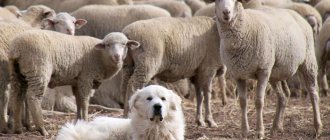brief information
- Country: Netherlands.
- FCI class: Shepherd dogs (herding and cattle dogs)
- Use: service dog, watchman, shepherd, companion.
- Color: brindle and its shades, gray-blue, fawn.
- Lifespan: 12-15 years
- Average weight: 29-30.5 kg.
- Height at the withers: females – 55-60 cm, males – 57-62 cm.
- Price: 35,000-60,000 rubles.
Photo: pxhere.com
Description of the breed
The Dutch Shepherd is a fairly large dog. By adulthood it grows up to 60 cm and has a fit and strong physique. It has a recognizable brindle color of various shades, but there are fawn and gray-blue specimens. There are three types of herder:
- wire-haired;
- short-haired;
- long-haired
The latter type is practically never found today. The Dutch Shepherd is loved by people not only for its beautiful appearance, but also for its abilities. This is a smart dog, distinguished by attentiveness and developed intelligence. Loves long, exhausting physical activity, suitable for keeping in an apartment.
Photo: pixabay.com
Standard
Modern breed standards were established in 1955. At exhibitions, the dog is evaluated according to the following parameters:
- Frame. The body is proportional, muscular and flexible. The body should be strong, but not heavy. It is necessary to have a powerful chest, due to which the animal is able to maintain breathing during intense physical exertion.
- Limbs. The paws are strong and muscular, the bones are well developed. Ligaments must be flexible and elastic. The angle between the thigh and the lower leg is obtuse, due to which the croup is slightly full. The hock joint is positioned so that the metatarsus has a vertical stance.
- The head is proportional to the body. The muzzle is dry and long, normally its length is approximately the same as the skull. In long-haired representatives it seems more massive. The ears are erect and set high. The shells are triangular in shape, pointed and directed forward. The eyes are medium in size, almond-shaped and black in color. Scissor bite.
- Wool. Coat standards differ depending on the breed subtype. In long-haired shepherd dogs, it is straight and long, with a well-developed undercoat. The ears are without fringe, and the hair on the hind legs, head and neck is short. Wirehaired Herders have short, tousled hair all over the body except the face. The beard, mustache and eyebrows stand out well. We accept bluish, motley, fawn and brindle colors.
- Tail. Shouldn't be very long. At rest, the shepherd holds its tail, a slight deflection is acceptable. When moving, it rises higher; falling to the side is unacceptable.
Dogs with white spots on the body and without a mask on the face are not allowed for breeding. The rounded and folded tips of the ears are considered a serious drawback. Males must have two prominent testes, fully descended into the scrotum. Cryptorchids are rare among representatives of this breed.
Appearance
The Dutch Shepherd is a strong, well-proportioned, medium-sized, slightly elongated dog. Height at the withers for males is 57-62 cm, for females 55-60 cm, weight ranges from 30-40 kg.
The head is proportional to the body, elongated, not massive, dry. The muzzle is slightly longer than the flat skull. The bridge of the nose is straight, parallel to the skull. The stop is weakly expressed. The lips fit tightly. In wire-haired dogs, the head appears more quadrangular, which it actually is not. The ears are small, erect, set high, directed forward. The eyes are medium-sized, almond-shaped, set slightly obliquely, dark in color. The nose is black. Scissor bite, strong teeth.
The neck is dry, of medium length, smoothly blending into the upper line of the body. The back is short, strong, straight. The loin is strong, not too long and not narrow. The croup should not be sloping or short. The chest is deep, not flat. Ribs slightly arched. Overall the body is strong and well balanced. The forelimbs are strong-boned, straight, well covered with hair on the carpal joints. The hind legs are uniformly strong, with strong bones and good muscles. The stifles are moderately angulated and the metatarsals should be vertical under the ischial tuberosities, which is ensured by a moderate angle of the hock joint. There are no dewclaws. The paws are well assembled. The pads are dark in color, the claws are black. The tail is straight, hanging or slightly curved, reaches the hock joint, and rises slightly during movement.
Based on the quality of their coat, Dutch Shepherds are divided into three types:
- Shorthair; The coat is short, hard, with a rich undercoat. The collar, trousers and hair on the tail are very well developed. The color is brindle on a brown or gray base. Stripes run along the entire body, as well as on the collar, pants and tail. A large amount of black topcoat is undesirable. A black mask is encouraged.
- Long-haired; throughout the body the coat is long, straight, rough to the touch, and does not form curls or waves. The undercoat is well developed. The hair on the head, ears, paws and hind legs below the hock is short. The back side of the forelimbs is covered with feathers. The tail is well bushed, but without fringe. The color is the same as that of the short-haired variety.
- Wirehaired; The coat is dense, hard, tousled except for the head. The undercoat is well developed and dense. Everywhere the wool should be tightly closed. On the head, the hair forms a mustache and beard, as well as disheveled eyebrows. On the skull and cheeks the hair is less developed. Plentiful pants are encouraged. The color is grey-blue, pepper and salt, golden or silver brindle. In brindle dogs with a hard coat, the stripes on the top coat are less pronounced than in other varieties.
The presence of large white spots on the chest and paws, as well as anywhere else on the body, is not welcome.
Unofficial type - Dutch Shepherd-X
Potential owners who are interested in buying a Dutch Shepherd puppy in the Netherlands will likely come across another type of these dogs, the so-called x-Dutch Shepherd. She is not bred according to FCI rules and is officially considered a crossbreed
She owes her appearance to the Royal Association of Dutch Police Dogs (KNPV), where documents and purebred were not given importance, but attention was paid exclusively to working characteristics. The Dutch Shepherds that are bred by the police are not all purebred, many of them are crossbreeds with Belgian Shepherds or other breeds, which is why their price is much lower
There are no documents, you can forget about exhibitions and an official breeding career, but the working qualities are often at their best.
Character and behavioral characteristics
Like all herding dogs, the Dutch Shepherd is distinguished by its balance and calm character. There may be distrust of strangers, he treats animals with restraint and friendliness, and does not attack without reason. She has strong guard skills and is capable of protecting people and property. The Herder has well-developed attention, keen hearing, vision and excellent reactions. In a number of countries, the breed is used for service work, as a guide dog.
Does not show aggression towards others without reason; with proper upbringing, he unquestioningly obeys his master. This is a very loyal dog that does not tolerate loneliness. Even from puppyhood, the Herder should be trained to remain alone. Gets along well with children, becoming a real member of the family.
Origin story
So little is known about the Dutch Shepherd breed outside the Netherlands that it is sometimes mistaken for the most “pedigree” court terrier or a ferocious wolf dog mixed with several breeds.
A direct descendant of the Belgian Shepherd, Herderhunder - the official name of the Dutchman, which has been assigned to him since 1860, was bred for a specific and quite noble purpose. In cattle breeding, the herding and guarding qualities of dogs, with which the Herder is endowed to the highest degree, have been and will continue to be of the highest degree of importance.
Education and training
The Dutch Shepherd needs early training and education. Socialization can begin as early as 3 months. Even if you do not plan to use the dog for work, when raising you need to pay attention to the following points:
- pay sufficient attention to physical activity - without it, the animal may exhibit destructive behavior or become lethargic. Endurance classes (agility) and running are recommended;
- security skills require constant monitoring and correction. The puppy must be trained not to pay attention to sharp sounds, other people and animals, or the doorbell;
- Aggression towards people and animals is unacceptable. The Herder is very loyal to its owner and can begin to protect even when there is no need for it, so it is important to teach it to hear and follow commands.
The disadvantage of the breed is that the dog does not tolerate loneliness well. May start barking and whining when left alone. With proper training, the Herder becomes an excellent companion; you can take him with you on trips, vacations and outdoor sports.
Character
The dog has a rather angry appearance due to the anthropological features of its head, which is why it is often used for service in the police, army and security.
The dog is ideal for the army, because it is considered a guard breed and needs constant physical activity. The pet is physically strong, practically tireless, focused and observant, has a keen eye, keen hearing and a cat-like reaction. Participation in sports competitions, search work, protecting livestock from predators - all these functions are not alien to the Dutch Shepherd, in some cases it is also used as a guide dog.
The dog is hyperactive and loyal. The character is adequate, rarely barks for no reason, does not rush at children, does not show aggression when teased or pulled by the tail and other parts of the body. Reacts aggressively to drunk people. Protecting the owner, it will bark without leaving him, because it is called upon to protect him. An attack occurs only in the event of a real threat to life. Herder was created for friendship with man and service to him.
It is quite difficult to earn a dog's trust and respect. It can be easily trained, but the best training option would be a combination of brute force and affection, because training for a Dutch Shepherd is primarily a game, so you should not overdo it with a firm hand, so as not to cause the dog a feeling of embitterment due to the presence of danger to its own life. The dog is not friends with tough and domineering people.
It is necessary to avoid serious punishments, and it is better to work with her by feeding her for a successfully completed task. These dogs are very smart and proud, and will not obey from the first days of training, so persistence is required. They are also extremely distrustful of strangers. As a result of proper upbringing, you can acquire a devoted family friend.
Walks
The dog needs regular and sufficient physical activity. This is important for maintaining your pet's health and fitness. Walks are required at least 2 times a day, the optimal total duration is 2-3 hours. The shepherd quickly learns to walk next to you and, because of its devotion, rarely runs off the leash. It is advisable to provide daily running load, systematically engage in commands that require intellectual tension. The Dutch Shepherd loves to chase a ball, disc or stick - this can be used as an exercise for endurance and speed.
Photo: pixabay.com
Character
Thanks to his good character and almost always cheerful mood, Schapendus has become very popular. As a rule, dogs raised at home as human companions are less independent and self-reliant than working dogs that continue to herd sheep.
Despite the fact that the schapendus is very friendly to friends and acquaintances, it perfectly protects its territory from strangers and will not allow a stranger to enter without the permission of its beloved owner. This agile, hardy dog has nerves of steel and will not show cowardice or timidity or, conversely, aggression for no apparent reason.
Schapendus is very obedient and easily obeys commands. The dog is quite balanced and will not bother you and your neighbors with barking for no reason. Thanks to her restraint and aristocracy, she will not conflict with other animals in the house, be it a dog, a cat or other living creatures. Therefore, by getting a schapendus, you will definitely maintain comfort and order in your home.
Diseases
The Dutch Shepherd does not have any serious hereditary diseases. A common problem for Herders is hip dysplasia. To avoid this disease in your pet, it is important to request pictures of the litter's parents. As a rule, large breeders and nurseries do them before planned mating.
With illiterate care and maintenance, there is a risk of bedsores and alopecia. In old age, dogs often experience decreased vision and develop cataracts or blindness. The lifespan of a shepherd dog can be up to 15 years. Like other breeds, puppies require routine vaccinations starting at 2 months.
Description and characteristics
At first glance, the Dutch Shepherd resembles a wolf or a mixture of several breeds. Before purchasing a puppy, it is worth remembering that this dog is not intended for an apartment, since in adulthood it reaches large sizes. A male at the withers grows up to 62 cm and weighs 28 kg, females are slightly smaller.
The dog has well-developed muscles, it has a strong back and a powerful lower back. The head is medium in size, the muzzle is long and elongated. The ears are triangular in shape and set up. The eyes are most often dark in color, sometimes completely black. The jaw is strong with a regular bite that creates a scissor effect. The tail is long and slightly curled to the side.
Related article: How to choose and adapt an East European Shepherd puppy
Estrus
In the Dutch Shepherd, the first heat occurs between the ages of 6 and 11 months. Normally, it lasts from 20 to 23 days, and then repeats with regularity up to 2 times a year. The dog's behavior and habitual way of life changes. The bitch becomes more lethargic or active, and her appetite changes. The main sign of the onset of estrus is increased urination and an increase in the size of the labia. During this period, all walks should only be on a short leash. It is advisable to wear special underpants indoors to make caring for your pet and cleaning up during discharge easier.
Mating
It is recommended to plan the first mating of a Dutch Shepherd in the second year of life - by this time the body and reproductive organs will be fully formed. The optimal period for carrying out the process is 10-12 days of estrus. Veterinarians recommend taking a special test to determine the condition of the eggs.
You need to select a pair for a herder based on height and weight. The male should be slightly smaller than the female. This allows you to avoid problematic births and caesarean sections. Both representatives of the breed must match in color, which is important to preserve the exterior characteristics. Acquaintance can be carried out both on the territory of a male and a female. It is important to provide comfortable conditions, since the dog is alert even when not in heat. Control mating is permissible no earlier than 24 hours after the first one.
Pregnancy
The gestation period for Shepherds varies from 50 to 56 days. During this time, the animal should be provided with high-quality and balanced nutrition, and serious physical and psychological stress should be avoided. The litter of this breed is small - 4-6 puppies; the first time a female produces fewer offspring. It is advisable to carry out childbirth only under the supervision of a veterinarian in order to avoid unpleasant consequences and carry out the necessary resuscitation measures in a timely manner.
The Dutch Shepherd has good maternal instincts. After giving birth, the bitch's guarding skills may become more acute. To prevent such changes, ensure that your pet is kept in a comfortable and quiet environment during this period.
Photo: wikimedia.org
Care
Herder does not require complex care. When working with a breed, it is important to take into account the characteristics of the coat, content and age. Recommendations for caring for a Dutch Shepherd:
- monthly inspect the ears, clean wax accumulations;
- in the summer, the claws grind down on their own; in the winter, they should be trimmed every month;
- check the condition of the eyes, clean them from dirt. If necessary, use special veterinary drops;
- How often you brush your teeth depends on your age and diet. When drying, the procedure is carried out less frequently than when drying. The optimal frequency of cleaning by a veterinarian is once a year. For prevention, allow chewing on dense treats, use a special paste;
- Hair care varies depending on its type. Brushing should be done weekly, especially during shedding periods. Only long-haired dogs need a haircut. Wire-haired representatives of the breed are trimmed 2-3 times a year, show dogs are plucked monthly;
- bathing is necessary 2-3 times a year; if the dog lives in an apartment, the procedure can be performed more often.
The pet should have its own place in the house, for example, a bed without sides. It is recommended to purchase only metal bowls, with the ability to adjust the stand to the height of the dog.
Photo: maxpixel.net
How to position the ears
Raised ears are a key feature of the breed and a prerequisite for exhibition. They are specially placed in puppyhood. A simple way to put ears on a Dutch Shepherd:
- Treat the sinks with a cotton pad soaked in hydrogen peroxide or Chlorhexidine.
- Place your ears vertically and place an ice cream stick or similar object made of natural materials nearby.
- Tape them with medical tape, creating a bridge between the ears.
Change the patch and sticks every 4-7 days or when soiled. With this method, the puppy’s ears stand up after 3-4 weeks. During this time, give vitamin and mineral supplements rich in calcium.
Care and maintenance
The Herder's coat can pose some maintenance challenges. At the same time, the animals do not have any health problems; they do not have a genetic predisposition to diseases.
It is advisable to keep the Dutch Shepherd in a private house with a large territory to provide the opportunity for walking.
Herder can live in an enclosure with a warm booth, although in severe frosts it is better to take him indoors. You cannot keep a dog of this breed constantly closed, because... she does not like loneliness; the owner and his family must pay attention to him. ' nails are usually trimmed once a month. They brush their teeth and check their ears and eyes weekly.
Nutrition
Herders are not prone to gastrointestinal problems, so any nutritious diet is suitable for them. This can be professional food or natural food with a lot of protein.
The finished food must be of the premium or super-premium category and labeled “for active dog breeds.” The manufacturer is selected based on the pet’s reaction, as well as the condition of the dog’s coat and activity.
Natural food must necessarily contain:
- Meat, but only lean varieties (beef, lamb);
- By-products;
- Dairy products;
- Cereal products (porridge);
- Vegetables.
Since this is a fairly large breed, it is better to include vitamins with calcium for proper bone development.
A puppy of this breed needs to be fed 5-6 times a day , by six months the number of meals can be reduced to 3 , and from 10 months and older, fed twice a day . It is better to adhere to the feeding schedule and the food dosages indicated on the package, since according to the standard the dog should be light and muscular, and in the case of constant overfeeding it will be difficult to meet the requirements.
We recommend that you read a detailed article on the topic: “How and what to feed a dog: types and characteristics of nutrition.”
Health
This breed is very healthy. She has no genetic problems and is not prone to colds, allergies, or gastrointestinal diseases.
Vaccinations
Vaccination of Dutch Shepherds follows the standard schedule.
7 days before the procedure, deworming is carried out. Before vaccination, the condition of the animal is assessed - a dog with signs of illness, as well as a lethargic and apathetic one, cannot be vaccinated.
Vaccination can prevent your pet from contracting the following diseases:
- Coronavirus;
- Hepatitis;
- Plague;
- Rabies;
- Trichophytosis;
- Parainfluenza;
- Parovirus enteritis;
- Leptospirosis.
Vaccination is carried out using a complex drug. The grafting intervals are as follows:
- 7-8 weeks – vaccination with DHPPiL;
- 12 weeks – vaccination with DHPPiL + R;
After each vaccination, puppies must be quarantined for 14 days , during which the baby cannot go outside. At this time, you need to carefully monitor your pet’s condition; if the temperature rises or other ailments occur, it is better to visit a veterinarian.
Adult dogs are vaccinated once a year; quarantine is not required.
Important article on the topic: “Everything you need to know about dog vaccinations.”
Diseases
The health of the breed is excellent, thanks to centuries of work in difficult conditions and the lack of selection for external parameters.
The only problem that may arise, common to many large breeds, is hip and elbow dysplasia. The disease does not manifest itself for a long time, although it is congenital.
If the owner notices that the dog has stiff movements, refuses to climb stairs, or wobbles in the lumbar region, then you should contact the clinic. The problem can lead to complete immobilization of the animal. Veterinarians advise at 15 months. Take an x-ray of all dogs so as not to miss the presence of pathology.
Walk
Dutch Shepherds require long, multi-hour walks. At this time, you will have to run with the dog, throw a frisbee to it, rollerblade or bike with it, and go hiking. You can also try dog obstacles, swimming, tug of war, and searching for objects and people.
Grooming
The coat of the Herderhunder has a thick undercoat. It is necessary to brush it at least once a week, and even more often for long-haired representatives. During shedding, it is better to use a furminator to avoid the presence of abundant fallen hair on furniture and clothes.
It is forbidden to cut the hair of representatives of this breed, as it does not grow back well. They should be washed rarely and without using shampoos.
In case of contamination, it is better to wipe the desired area with a damp cloth. Wire-haired dogs need to be trimmed twice a year, that is, remove dead hairs by plucking.
Feeding
Dutch Shepherds are not picky eaters. They adapt to both natural nutrition and dry food. They will benefit from an active breed diet rich in protein and carbohydrates. They rarely suffer from allergies, so the ingredients are selected depending on the pet’s taste preferences. The feeding regime of puppies and their diet differs from adults. At the age of up to 6 months, the dog should be fed every 3-4 hours, then switched to the classic mode - 2-3 times a day.
Photo: wikimedia.org
Tips for choosing puppies
You can wean a puppy from its mother at the age of 2-3 months. They quickly socialize and get used to their owner. When choosing a pet, pay attention to appearance and behavior. The dog must be active and curious; it is not recommended to purchase frightened, confused puppies. You should check the condition of the coat - it should be uniform, without white spots or signs of alopecia. The limbs of a healthy individual are mobile, without pronounced markings. Check the presence of all documents for the litter, ideally - x-rays of the parents for the absence of dysplasia.
Choosing a Dutch Shepherd puppy
When choosing a puppy, you should take into account many nuances, as well as the purpose for which the dog is purchased. Here's what's important to know:
- You should purchase a dog from a trusted breeder or from a kennel.
- The pet must have a pedigree, because otherwise there will be no guarantee of its compliance with accepted standards and health.
- The dog's parents must be healthy and also have documents and breed titles. Also, all babies in the litter must undergo certification, and the mating must be registered.
- When choosing, you need to take into account that it is impossible to determine whether they are shorthaired or some other type of coat and its shade, since they are born black, and the stripes appear with age.
Important! It is impossible to choose a puppy based on the principle “whoever comes first will be bought.” Henders are extremely distrustful and may not approach you right away. But when choosing, the dog should not show cowardice or aggression.
Buying Dutch puppies for home and exhibitions
Owner reviews
Arkady K. “We found a Dutch Shepherd puppy in France. Zhora has been living with us for 5 years. During this time we faced various difficulties. It was difficult to stop him from barking in the apartment and chewing furniture. With age, the song has calmed down a little, but if you don’t take a good walk, it can be too active.”
Anna E. “I have long dreamed of owning a Herder. I was looking for a puppy for a long time, the choice fell on a brindle girl. This is a very smart, beautiful and loyal dog. I spend a lot of time with her, doing agility. I believe that the breed has no disadvantages.”



